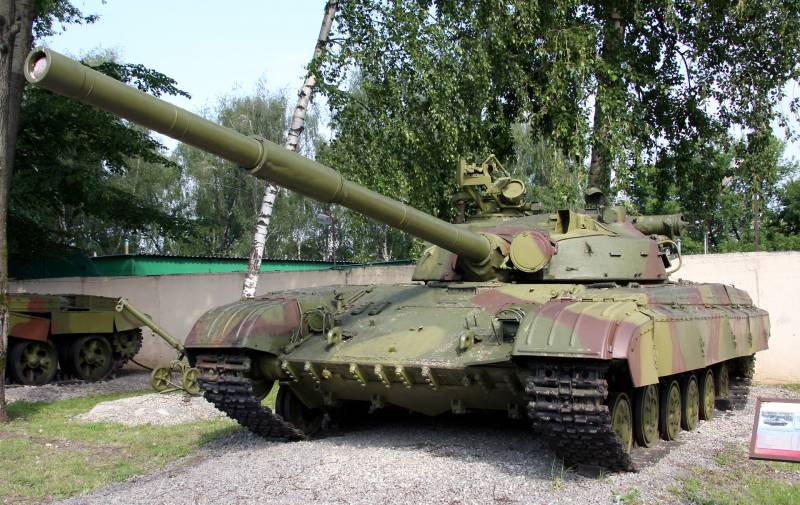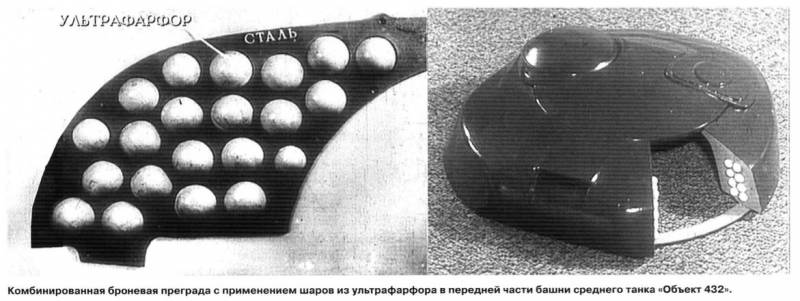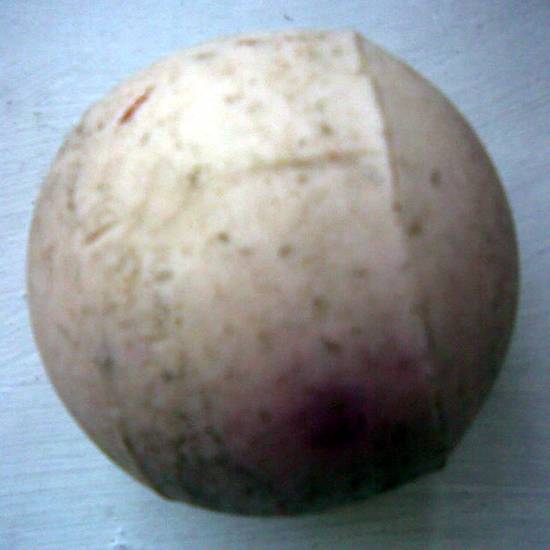How ultra-porcelain balls appeared in the T-64 turret

T-64A. Source: wikipedia.org
VNII-100 steers
Understanding that traditional homogeneous armor can no longer provide protection tank from modern anti-tank weapons, it came to engineers back in the early 50s. More precisely, 100% steel armor can theoretically protect against a cumulative jet, but the thickness will be prohibitive. For example, to protect against an 85-mm HEAT non-rotating projectile with a steel funnel within heading angles, an additional 3,7 tons of armor was required. The calculations are valid for the experimental "object 430", which is considered one of the predecessors of the T-64. Serial at the end of the 50s, the T-55 required more than 7 tons of additional armor to protect against similar ammunition. No one was going to repeat the mistakes of the German tank industry of the early 40s, and the designers of VNII-100 began to look for an alternative solution.
A little help. VNII-100 or the All-Russian Research Institute of Transport Engineering (VNIItransmash) is a secret research and production enterprise specializing in tank building. It is safe to say that it was the Leningrad VNII-100 that set the main directions for the development of domestic tanks. Kharkov, Nizhny Tagil and Omsk design bureaus were in this case in the status of subordinates. It is interesting that quite often the institute was entrusted with tasks that were completely unusual for the profile - for example, the development of the design of the world's first planetary rover "Lunokhod - 1". In the early 60s, VNIItransmash design engineer Alexander Kemurdzhian was, frankly, not the most promising topic of hovercraft tanks. The development of the lunar rover entrusted to him not only glorified the engineer throughout the world, but also determined the development of the design of planetary rovers for many years.
But back to tank building, the main activity of VNII-100. In the early 60s of the last century, all the forces of the domestic "transport engineering" (everything related to the tank industry was so naively encrypted) were thrown into the development of the revolutionary T-64 tank or "object 432". In one of the numerous conclusions on the research work of the institute, declassified not so long ago, there are unique chronicles of the birth of Soviet combined armor. One of these relates to the topic HB12-208-63 and is dedicated to
The deadline for completing work on the topic is the fourth quarter of 1963. The report illustrates well the ways to increase the projectile resistance of the cast turret of a promising tank. If you do not take into account the screens that covered the side projections of the tank, then there were few options - either to thicken the armor due to light alloys, or to introduce non-traditional fillers. Aluminum looked promising, allowing you to increase the thickness of the armor by 33% without increasing the mass. Titanium looked even better as part of a “steel + titanium + steel” sandwich, which made it possible to save up to 40% of the mass with the same thickness of the armored barrier. By the way, aluminum was not used when armoring the T-64 hull; for this purpose, fiberglass sheets 105 mm thick were used, clamped on both sides with rolled armor.
For obvious reasons, it was impossible to use fiberglass filler in a cast tower - it would simply burn out when pouring a liquid alloy. Therefore, the armor of the turrets of the first mass-produced tanks was a layered cake of armor, aluminum and armor again. According to the technology, aluminum alloy was already poured into the finished steel jacket of the tower.

The initial experimental work at VNII-100 was built around firing 115-mm cumulative projectiles from the Molot cannon on combined armor. The report, in dry official style, describes the following:
By the way, the 115-mm tank gun was at that time the most powerful weapon in its class in the world.
Ultraporcelain to the masses
In 1963, the domestic industry was already able to cast turrets with combined armor. For example, for the first "objects 432" technical projects planned aluminum filler back in 1961. Casting was carried out by the Mariupol Metallurgical Plant, where experimental towers were fired from 85-mm and 100-mm guns. That is why the first T-64s were equipped with turrets with an aluminum layer. The disadvantage of this design was a slight buckling of the aluminum layer in the upper part when an armor-piercing projectile hit the middle and upper parts of the tower. There was nothing surprising in this - aluminum is much more plastic than cast armor, and the impact of the projectile squeezes out the filler through any cracks, like toothpaste from a tube. VNII-100 engineers recommended that a steel bridge between the visor and the base of the tower be provided in the design, as well as the use of a more durable aluminum alloy.
There were problems with ultra-porcelain, more precisely with corundum, in the armor of the tower. As Vsevolod Vasilievich Ierusalimsky, deputy director for research at the Moscow branch of VNII-100, notes, the introduction of corundum balls into the thickness of the cast armor of the tower was accompanied by large defects. First of all, in order to place the balls in the casting, it was necessary to mount spiral springs along the walls of the mold, holding the balls in the desired position. Jerusalem writes:
The presence of metal reinforcement in the thickness of the armor, which reduced the solidity of the structure, had a negative effect on the survivability of the tower. In 1963, casting armor with ultra-porcelain balls was a non-trivial task. It was not clear how to pour liquid metal into the finished shirt at all. For example, if metal is poured into a tower installed with the roof up, then there will inevitably be many casting defects (shrinkage holes, looseness, etc.) just because of the presence of a large number of balls and fastening reinforcement. A likely solution to this problem could be the siphon pouring of steel, that is, when the liquid metal rises from the bottom up in the form, but this dramatically increased the cost and labor for the manufacture of towers. According to the calculations, corundum balls with a diameter of 88 mm seemed to be the most optimal, taking into account a layer of glass 5 mm thick and 10 mm refractory chamotte. There was also an option with 40 mm balls, but liquid steel could not completely fill the gaps between such small objects.

Corundum ball. Source: btvt.narod.ru
Why was it necessary to fence a complicated technology with ultra-porcelain balls at all? It's all about the unique properties of corundum or, in other words, aluminum oxide. This material, like any other ceramic, combines low density with extremely high strength. Only now, when critical loads are reached, corundum is deformed with little or no transition to a plastic state, that is, it simply crumbles. When molded corundum balls are poured with liquid armor, the cooling shell compresses the elements with a force of several tons per square centimeter. The report comments on this:
The sequence of events when a cumulative ammunition hits the armor with corundum balls is as follows - the shock wave destroys the ultra-porcelain, followed by a decrease in pressure and the crumbled fragments block the path of the metal jet. It is far from always possible to finally stop the erosion of armor with cumulative ammunition, but the most dangerous head of the jet is destroyed by ultraporcelain. But by the beginning of the 60s, these were nothing more than theoretical calculations.
Vsevolod of Jerusalem, obviously, was one of the opponents of porcelain in armor, and retorted:
In addition, 840 kg of non-ferrous metal is poured into the aluminum-filled tower, and 3,0 kg less ultra-porcelain balls are filled. Corundum is heavier than aluminum - 2,65 g / cu. cm vs. 600 g/cu. cm. Thus, with a thickness of a tower with aluminum of 560-550 mm along the jet and a tower with ultra-porcelain of 570-400 mm, the latter is XNUMX kg heavier.
Nevertheless, by the end of 1963, full-scale tests of the tower with spherical ultra-porcelain fillers were carried out. The shelling showed that the survivability from 100-mm and 115-mm shells approximately corresponds to the same tower, but made of monolithic armor. And most importantly, ultra-porcelain provided greater survivability compared to aluminum filler. However, it took more than ten years to wait for the appearance of ultra-porcelain in tank armor - the first T-64A with corundum fillers of cast armor of the towers appeared only in 1973.
Information